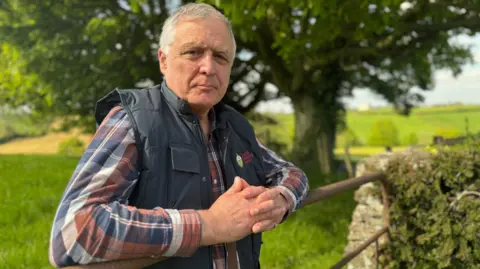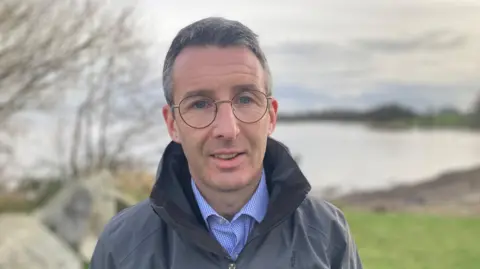Farmers say NI pollution proposals 'out of touch'
 BBC
BBCFarmers have said plans to reduce water pollution as a result of agricultural activity are "out of touch" with the reality of agriculture.
Northern Ireland's long-overdue Nutrients Action Programme (NAP) for 2026-29 has been published for consultation.
Many of the proposals are linked to the Lough Neagh Action Plan.
Making low emission slurry spreading equipment (LESSE) mandatory and placing restrictions on the use of phosphorus fertiliser are among recommended revisions.
'Farmers are not shying away'
President of the Ulster Farmers' Union, William Irvine, said it was "deeply concerning" the proposals from the Department of Agriculture, Environment and Rural Affairs (Daera) "lean heavily" towards enforcement and regulation rather than education, incentives or collaboration with farmers.
"Farmers are not shying away from their responsibilities," he said.
"For the last 20 years, since NAP was first introduced, we have been implementing practices to improve water quality.
"We fully recognise the need to protect and improve water quality, but it must be done in a way that's balanced, fair and grounded in the day-to-day realities of farming in NI.
"The proposals within NAP reflect a clear disconnect with local agriculture and fail to deliver what's truly needed."
Daera said it was "widely recognised that the intensification of agricultural production has had negative impacts on the environment".

Welcoming the consultation, the Northern Ireland Environment Link (NIEL) - which represents more than120,000 individuals and the management/ownership of 314,000 acres of land - said the NAP was a "starting point for improving NI's precious freshwater environment".
"We recognise that delivering these changes will not be easy and acknowledge the challenge that many farmers face in adapting to new restrictions and practices, particularly amid rising costs and a continuously shifting policy and regulation landscape," a spokesperson said.
"That's why we're calling for a strong programme of advice, investment and long-term support to enable a just and workable transition."
Why is the plan being introduced?

Daera Minister Andrew Muir said action was needed to improve water quality and meet legal obligations.
"This is why it is essential to review NAP and consider additional measures to reduce the overall phosphorus surplus in our agricultural system," he said.
"The main additional measures include further restrictions on use of chemical phosphorus fertiliser and a farm phosphorus balance limit for more intensive farms."
He added that while 62% of the nutrient load in waterways could be traced back to to agriculture, other sources such as wastewater treatment and septic tank seepages also play a role.
His department also wants to "enhance" the enforcement powers available to it, to apply fixed or variable monetary penalties for breaches of the NAP.
'Permission to pollute'
Speaking on BBC's The View, Muir said he recognised that the measures proposed in the NAP are "challenging" and the consultation is "very complex".
"Ultimately we do need to change so we can improve our waterways and I don't want to consign Lough Neagh to the scenes we've seen in recent years," Muir said.
He added that since NI Water was established in 2007 they have had a "permission to pollute".
He added that he was "fed up" with the lack of investment in wastewater infrastructure, and that the Infrastructure Minister Liz Kimmins "needs to get her head out of the sand and needs to turn the situation around".
"What I am being left with as the minister for agriculture, environment and rural affairs is the job of cleaning up the sewage that NI Water are pumping into our waterways."
On Friday, the minister announced that the consultation would be extended to 12 weeks and will now close on 24 July.
"I recognise that the proposals in the revised NAP have a level of complexity because of the detailed science and evidence underpinning them," he said.
"Therefore, having listened to the concerns from farmers and industry about the need for more time to consider the consultation proposals, I am extending the consultation period by four weeks."
Muir said the extension is an "important opportunity" for people to respond or offer alternative proposals, and stressed that no final decisions have yet been made.
Better ways of using slurry
Intensive farms – mostly dairy and some beef farms - can be granted a derogation for using slurry on their land, allowing them to apply up to 250kg nitrogen per hectare per year from grazing livestock manures, rather than 170kg.
The number of farms that currently have a derogation is 427.
The lower limit for nitrogen would be reduced to 150kg/N/ha/year, putting another 3,100 farms in the category.
In total, the consultation document said, these farms account for 17% of all farms, yet produce some 50% of total manure nitrogen.
They will also represent a significant proportion of surplus phosphorus because of their greater reliance on feed inputs.
These farms would also be subject to a Phosphorus Balance Limit of 10kg/ha/year in 2027, reducing to 8kg in 2029.
Other schemes seeking ways of better using slurry and the nutrients it contains include the sustainable use of livestock slurry and using slurry to generate biogas.
